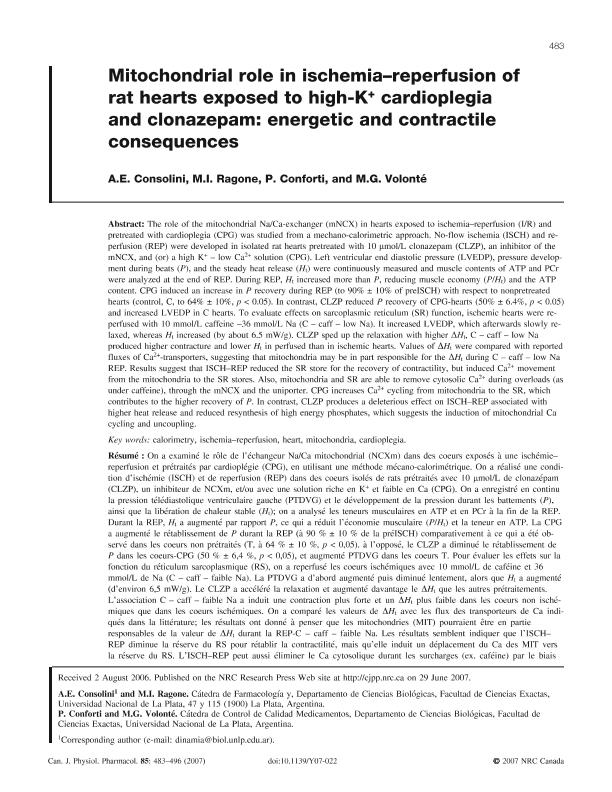Mostrar el registro sencillo del ítem
dc.contributor.author
Consolini, Alicia Elvira

dc.contributor.author
Ragone, María Inés

dc.contributor.author
Conforti, Paula Andrea

dc.contributor.author
Volonté, Maria Guillermina

dc.date.available
2020-07-23T14:40:00Z
dc.date.issued
2007-05
dc.identifier.citation
Consolini, Alicia Elvira; Ragone, María Inés; Conforti, Paula Andrea; Volonté, Maria Guillermina; Mitochondrial role in ischemia–reperfusion of rat hearts exposed to high-K + cardioplegia and clonazepam: energetic and contractile consequences; National Research Council Canada-NRC Research Press; Canadian Journal Of Physiology And Pharmacology; 85; 5; 5-2007; 483-496
dc.identifier.issn
0008-4212
dc.identifier.uri
http://hdl.handle.net/11336/110011
dc.description.abstract
The role of the mitochondrial Na/Ca-exchanger (mNCX) in hearts exposed to ischemia–reperfusion (I/R) and pretreated with cardioplegia (CPG) was studied from a mechano-calorimetric approach. No-flow ischemia (ISCH) and reperfusion (REP) were developed in isolated rat hearts pretreated with 10 µmol/L clonazepam (CLZP), an inhibitor of the mNCX, and (or) a high K+ – low Ca2+ solution (CPG). Left ventricular end diastolic pressure (LVEDP), pressure development during beats (P), and the steady heat release (Ht) were continuously measured and muscle contents of ATP and PCr were analyzed at the end of REP. During REP, Ht increased more than P, reducing muscle economy (P/Ht) and the ATP content. CPG induced an increase in P recovery during REP (to 90% ± 10% of preISCH) with respect to nonpretreated hearts (control, C, to 64% ± 10%, p < 0.05). In contrast, CLZP reduced P recovery of CPG-hearts (50% ± 6.4%, p < 0.05) and increased LVEDP in C hearts. To evaluate effects on sarcoplasmic reticulum (SR) function, ischemic hearts were reperfused with 10 mmol/L caffeine –36 mmol/L Na (C – caff – low Na). It increased LVEDP, which afterwards slowly relaxed, whereas Ht increased (by about 6.5 mW/g). CLZP sped up the relaxation with higher ΔHt, C – caff – low Na produced higher contracture and lower Ht in perfused than in ischemic hearts. Values of ΔHt were compared with reported fluxes of Ca2+-transporters, suggesting that mitochondria may be in part responsible for the ΔHt during C – caff – low Na REP. Results suggest that ISCH–REP reduced the SR store for the recovery of contractility, but induced Ca2+ movement from the mitochondria to the SR stores. Also, mitochondria and SR are able to remove cytosolic Ca2+ during overloads (as under caffeine), through the mNCX and the uniporter. CPG increases Ca2+ cycling from mitochondria to the SR, which contributes to the higher recovery of P. In contrast, CLZP produces a deleterious effect on ISCH–REP associated with higher heat release and reduced resynthesis of high energy phosphates, which suggests the induction of mitochondrial Ca cycling and uncoupling.
dc.format
application/pdf
dc.language.iso
eng
dc.publisher
National Research Council Canada-NRC Research Press

dc.rights
info:eu-repo/semantics/openAccess
dc.rights.uri
https://creativecommons.org/licenses/by-nc-sa/2.5/ar/
dc.subject
CALORIMETRY
dc.subject
ISCHEMIA-REPERFUSION
dc.subject
HEART
dc.subject
MITOCHONDRIA
dc.subject
CARDIOPLEGIA
dc.subject.classification
Otras Ciencias Químicas

dc.subject.classification
Ciencias Químicas

dc.subject.classification
CIENCIAS NATURALES Y EXACTAS

dc.subject.classification
Métodos de Investigación en Bioquímica

dc.subject.classification
Ciencias Biológicas

dc.subject.classification
CIENCIAS NATURALES Y EXACTAS

dc.title
Mitochondrial role in ischemia–reperfusion of rat hearts exposed to high-K + cardioplegia and clonazepam: energetic and contractile consequences
dc.type
info:eu-repo/semantics/article
dc.type
info:ar-repo/semantics/artículo
dc.type
info:eu-repo/semantics/publishedVersion
dc.date.updated
2020-07-20T20:21:03Z
dc.identifier.eissn
1205-7541
dc.journal.volume
85
dc.journal.number
5
dc.journal.pagination
483-496
dc.journal.pais
Canadá

dc.journal.ciudad
Otawa
dc.description.fil
Fil: Consolini, Alicia Elvira. Universidad Nacional de La Plata. Facultad de Ciencias Exactas. Departamento de Ciencias Biológicas. Cátedra de Farmacología; Argentina
dc.description.fil
Fil: Ragone, María Inés. Universidad Nacional de La Plata. Facultad de Ciencias Exactas. Departamento de Ciencias Biológicas. Cátedra de Farmacología; Argentina. Consejo Nacional de Investigaciones Científicas y Técnicas; Argentina
dc.description.fil
Fil: Conforti, Paula Andrea. Provincia de Buenos Aires. Gobernación. Comisión de Investigaciones Científicas. Centro de Investigación y Desarrollo en Criotecnología de Alimentos. Consejo Nacional de Investigaciones Científicas y Técnicas. Centro Científico Tecnológico Conicet - La Plata. Centro de Investigación y Desarrollo en Criotecnología de Alimentos. Universidad Nacional de La Plata. Facultad de Ciencias Exactas. Centro de Investigación y Desarrollo en Criotecnología de Alimentos; Argentina
dc.description.fil
Fil: Volonté, Maria Guillermina. Universidad Nacional de La Plata. Facultad de Ciencias Exactas. Departamento de Ciencias Biológicas. Cátedra de Control de Calidad de Medicamentos; Argentina
dc.journal.title
Canadian Journal Of Physiology And Pharmacology

dc.relation.alternativeid
info:eu-repo/semantics/altIdentifier/url/https://www.nrcresearchpress.com/doi/abs/10.1139/Y07-022#.XxdVo55KhPY
dc.relation.alternativeid
info:eu-repo/semantics/altIdentifier/doi/http://dx.doi.org/10.1139/y07-022
Archivos asociados
